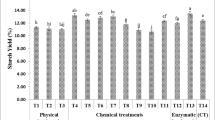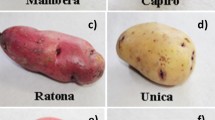Conclusions and Summary
The percentage of starch in white potatoes has been shown to vary widely with the variety and many climatic and cultural conditions from as low as 9.6 in the Earlaine No. 2 variety, grown only to a slight extent, to 20.0 in Green Mountains. Some samples of commercial potatoes of the Bliss variety have tested as low as 8 per cent. The average starch content of all Maine seed and table stock potatoes is now about 12 per cent (1950 crop). This average can change rapidly because of changes in the per cent grown of relatively low and high starch potatoes. The present trend is apparently toward higher starch potatoes.
Next to starch in order of quality is nitrogenous material as proteins, intermediate hydrolysis products of proteins, and amino acids. The nonstarch carbohydrates, as cellulose, pentozans, pectins, etc., then usually follow although they may exceed the nitrogenous compounds. Then come the mineral compounds, especially potassium phosphate. Last is the large number of compounds as the organic acids, enzymes, ether extractives as fat and oil, and enzymes, which are present in very small quantities, and vitamins, present in traces.
The composition of white whole potatoes can be summarized approximately as follows, the analytical data having been collected from much new and old original data from the writer’s laboratory and from many published sources.
Similar content being viewed by others
Literature Cited
Appleman, C. O. and Miller, E. V. 1926. A chemical and physiological study of maturity in potatoes. Jour. Agr. Res. 33: 569–577.
Artschwager, E., 1924. Studies on the potato tubers. Jour. Agr. Res. 27: 809–836.
Assn. of Agr. Chemists, Methods. 1935, 1940. Official and tentative methods of analysis. Assn. Official Agr. Chem.
Balks, R. 1935. Iodine Content of Foodstuffs. Z. Unters. Lebensm. 71:76.
Bertrand, G. and Benzon, B., 1928. La tenuer en zinc des aliments vegetable. Chimie Biologique. Comptes Rendus de L’Acad. Sci. 187: 1098.
—, and Levy, G. 1931. La teneur des plantes, notamment des plantes alimentaires en aluminium. Comptes Rendus de L’Acad. Sci. 192:525.
Booher, L. E. and Hartzler, E. R., 1939. The vitamin B1 content of foods in terms of crystalline thiamin. U.S.D.A. Tech. Bull. 707:15.
-, Hartzler, E. R. and Heweston, E. M., 1942. A compilation of the vitamin values of foods in relation to processing other vitamins. U.S.D.A. Circular No. 638.
Brautlecht, C. A., 1939-1940. White potato Starch Report New England Assn. Chem. Teachers’. Ind. Eng. Chem. 32:893.
Bunzell, H. H. and Kenyon, M., 1933. On potato catalase. Bull. Torrey Botan. Club 60:469–474.
Canned Food Reference Manual, 1939. Page 197.
Droste, R. Hanover. 1915. Significance of Solanine. Pharm. Centralhalle, 311–312.
Eynon, L. and Lane, J. H. 1928. Starch, its technology and uses.
Fixsen, M. A. B., and Roscoe, M. H., 1937. Nutrition abstracts and reviews. 7:823–867.
Fraps, G. S. and Fudge, J. F., 1939. Iodine in city waters and vegetables in Texas. Food Research 4:360.
Fraser, S., 1905. The Potato.
Frear, D. E. H., 1934. Study of the iodine content of Pennsylvania potatoes. Jour. Agr. Res. 48:171–182.
Freedman, S. P., 1942. White Potato Ash (Unpublished thesis for B. S. Degree), Maine.
Goldthwaite, N. E., 1925. Variations in the composition of Colorado potatoes. Colo. Agr. Exp. Sta. Bull. 296. (1925B)
Grub, E. H. and Guilford, W. S., 1912. The potato. 523.
Guerithault, B. 1920. Sur la presence de cuivre dans les plantes et particulierrement dans le materedo. Comptes Rendus de L’Acad. Sci. 171:196.
Guthrie, J. D. 1934. Metabolism of citric, sulphuric, and nitric acid in the potato tuber; an explanation for the high pH of the juice of tubers treated with ethylene chlorhydrin. Boyce Thompson Inst. 6:247–268.
— 1939. Isolation of citric acid from potato tubers. Boyce Thompson Inst. 8: (4)295–296.
Headden, W. P., 1927. Effects of nitrates on composition of the potato. Colo. Agr. Exp. Sta. Bull. 325.
Heller, V. G., Jones, M. and Pursell, V., 1935. Iodine content of Oklahoma Vegetables. Okla. Agr. Exp. Sta. Bull. 229.
Jenkins, E. H. and Winton, A. L. 1892. A compilation of analyses of American feeding stuffs. U.S.D.A. Office of Exp. Sta. Bull. 11.
Jones, D. B. and Nelson, E. M., 1931. Nutritive value of potato protein and of gelatin. Jour. Biol. Chem. 91:707–713.
Langworthy, C. F. 1907. Potatoes and other root crops as food. U.S.D.A. Farmers’ Bull. 295.
Mattsdorff. (Ref. from Eynon and Lane, Starchetc. (loc. cit.) P. 98.) ......
Morgen, A., 1879. Die Stickstoffhaltigen Bestandtheile der Kartoffeln. Deutsche Landwirtschaftliche Presse, 533.
Murphy, E. F., Dove, W. F. and Akeley, R. V. 1945. Observations on genesis, physiological, and environmental factors affecting the vitamin C content of Maine grown potatoes. Amer. Potato Jour. 22:62–80.
Osborne, T. B. and Campbell, G. F. 1896. The proteids of the potato. Jour. Am. Chem. Soc. 18: 575.
Parow, E. 1928. Handbuch der Starkefabrikation, Berlin, Paul Parey.
Peterson, W. H. and Elvehjem, C. A., 1928. The iron content of plant and animal foods. Jour. Biol. Chem. 78:218–223.
Pfankuch, E. Z. 1936. Uber die phosphatase der kartoffel und der zuckerrube. Z. Physiol. Chem. 241 34–36.
Rathsack, H. 1935. Der Speisewert der Kartoffel. P. 120.
Reed, T., 1910. On the anatomy of some tubers. Ann. Bot. 24:537–548.
Remington, R. F. and Shiver, H. E. 1930. Iron, copper and manganese content of some common vegetable foods. Jour. Assn. Off. Agr. Chem. 13:129–132.
Roach, W. A. 1925. A labile blue compound from the potato tuber. Ann. Bot. 39: 883.
Robertson, I. M. and Smith, A. M., 1931. A study of the hydrogen ion concentration of the potato tuber. Biochem. Jour. 25: 763–769.
Sherman, H. C., 1907. Iron in food and its functions in nutrition. Office of Exp. Sta. Bull. 185: 3–80.
Saare, O. 1897. Die Fabrikation der Kartoffelstaerke, Springer, Berlin.
-. 1899. Z. Spiritus Industriez.
Scheunert, A., Reschke J. and Kohleman, E., 1936. Uber den Vitamin C Gehalt der Kartoffeln. I. Mitteiling. Alte gelagerte Kartoffeln der Ernte. (1935). 288:261.
Scheele, C. Von and Svensson, G., 1931. Uber polarimetrische Bestimmung der Kartoffelstarke sowie uber den Zusammenhang zwischen dem Trochkensubstanz und Starkegehalt der Kartoffeln. Lanuw. Versuchs. Sta. 112: 1–43.
Schulze, E. and Barbieri. 1878. Uber den Gehalt der Kartoffelknollen und Eiswisstoffen und an Amiden, Versuchs. Sta. 21:63–92.
Sjollema, B. and Rinkes, I. J., 1911. Die hydrolyse des Kartoffeleiweisses. Zeit. Physiol. Chem. 76:369.
-, 1931. Die hydrolyse des Kartoffeleiweisses. Landw. Versuchs. Sta. 112:
Schweitzer, G. G., 1926. Arb. Biol. Reichs., Land. Forstw. 15: 1.
Sweetman, M., 1936. Factors affecting the cooking quality of potatoes. Maine Agr. Exp. Sta. Bull. 383.
Thiessen, 1936. Effect of storage upon the vitamin C content of Wyoming potatoes. Wyo. Agr. Exp. Sta. Bull. 215: 3.
Underhill, F. P., Peterman, F. I., Gross, E. G. and Krause, A. S., 1929. The aluminum content of some fresh foods. Amer. Jour. Physiol 90:72.
Whalley, M. E., 1935. The chemical composition and nutritive value of potatoes. National Research Council, Canada.
Winton, A. L. and Winton, K. B., 1935. The structure and composition of foods, (No reference available)
Woods, E., 1935. The vitamin C content of the Russet Burbank potato of Idaho. Idaho Agr. Exp. Sta. Bull. 219: 3.
Yoshimura, K. 1934. Vorkommen on organischen basen besonders von cadaverin in Kartoffelknollen. Biochem. Z. 274, 408.
Author information
Authors and Affiliations
Rights and permissions
About this article
Cite this article
Brautlecht, C.A., Getchell, A.S. The chemical composition of white potatoes. American Potato Journal 28, 531–550 (1951). https://doi.org/10.1007/BF02850251
Accepted:
Issue Date:
DOI: https://doi.org/10.1007/BF02850251




